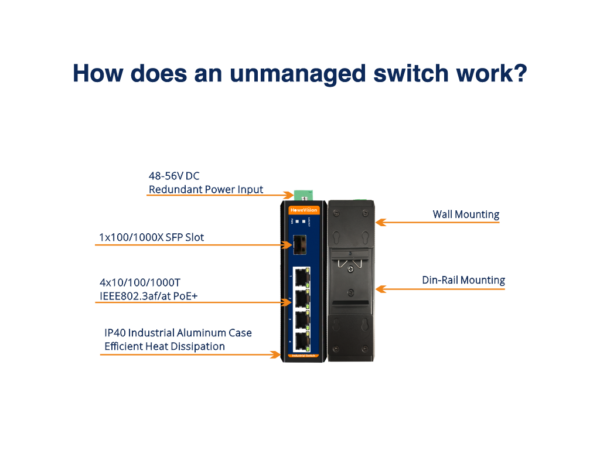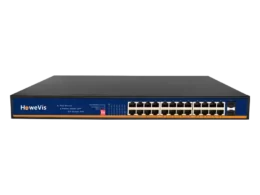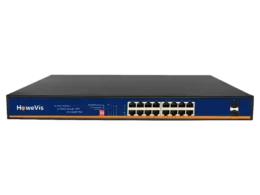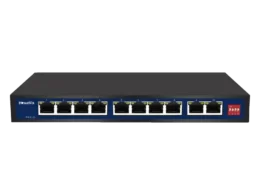An unmanaged switch is a simple switch. By that means, it doesn’t involve any complex mechanism of function. You need to turn on your switch, and boom! All your devices will act as integrated devices in the network.
So, an unmanaged switch connects your devices and performs as a bridge, just like a typical switch.
Have you ever observed a network? What technology does it involve? The type of switches and wires? Nowadays, we have advanced options. I’m talking about the Gigabit Ethernet that can offer you up to 100GB per second. Isn’t it fantastic? We often use unmanaged Ethernet switches in power over Ethernet. Thus, an unmanaged Ethernet switch works on the principles of PoE 802.3 standards.
If you would like to know about the power over Ethernet, have a look at —How PoE was born?
What is an unmanaged PoE switch?
A quick task for you. What does it mean by unmanaged? Something that is not managed, right? Apply this concept to the unmanaged PoE switch.
An unmanaged PoE switch is a PoE switch that doesn’t offer any configuration for the network. By that means, just plug-and-play. No extra features that you can expect from managed or intelligent switches. That’s why we call it an unmanaged PoE switch.
How many types of switches a PoE network has?
In a PoE network, there are three basic types of switches.
- Managed Switch
- Unmanaged Switch
- Hybrid or Web Smart switch
A managed switch is precisely the opposite of an unmanaged switch. It offers custom configuration and multiple other aspects related to networking.
Contrary to it, the unmanaged lacks multiple features such as management and custom configuration.
I suppose you already understand the hybrid switch. Can you define it? As the name suggests, the hybrid switch offers managed and unmanaged features.
How exactly does an unmanaged switch work?
Do you want to know the mechanism of working for an unmanaged switch? No worries, recall Power over Ethernet. Upon what principles does it work? Institute of Electrical and Electronics Engineering(IEEE) 802.3 standards.
Being unmanaged, you can plug in your switch and connect the devices. It will provide you with high-speed data up to 1GB per second. Isn’t it sufficient for your work? The data packets pass through the unmanaged switch from the host device to the destination device.
To which network layer to an unmanaged switch belongs?
In actuality, three layers of the network are there.
- Core Layer
- Distribution Layer
- Access Layer
The core layer is the network’s backbone empowering distribution and access switches. The distribution layer is the middle layer, while the access layer is the outermost layer of the network.
Unmanaged switches usually belong to the access layers. Do you know why? Because they work as a bridge. The switch must have additional features such as routing in core or distribution layers.
Which layer type is the unmanaged switch?
I have a quiz for you. There are two types of layer switches.
- Layer 2
- Layer 3
Layer 2 is a primary switch that bridges the network. In simple words, plug and play switch.
Layer 3 is an advanced switch providing routing and bridging features.
So, guess which type the unmanaged switch is? Layer 2 switch, right? Great! You are right.
What does an unmanaged switch does in the network?
Unmanaged switch plays an essential role in the network connecting devices. Moreover, if you want high-speed data over the PoE 802.3bt standard, an unmanaged switch can help you get it. Here is what it can do for you in the network.
- The unmanaged switch connects the devices.
- A typical switch. Even more manageable when we call it a plug-and-play switch. By that means, you need to plug in your switch and turn it on. The unmanaged switch will empower the devices and connect them over the network. In the access layer, you can only expect the basic functionality of the switch. For small networks, this is a great switch. However, in the case of complex networks, you need to employ other types of switches, such as managed and intelligent web switches.
- It provides a high-speed data connection.
- Guess unmanaged switch uses what? PoE technology, right? Therefore, you can expect a 1GB per second speed from it. Especially if I mention PoE 802.3bt, it can provide you with data speed in gigabytes. Isn’t it great for your network?
If you want to know the types of PoE, you can check another guide—What Are the Different Types of PoE?
-
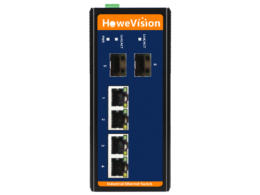 Industrial Gigabit Ethernet Switch, 4-Ports Gigabit Ethernet RJ45, 2-Ports Gigabit SFP Uplink
Industrial Gigabit Ethernet Switch, 4-Ports Gigabit Ethernet RJ45, 2-Ports Gigabit SFP Uplink -
 Industrial Gigabit Ethernet Switch, 4-Ports Gigabit Ethernet RJ45, 1-Port Gigabit SFP Uplink
Industrial Gigabit Ethernet Switch, 4-Ports Gigabit Ethernet RJ45, 1-Port Gigabit SFP Uplink -
 Industrial Gigabit Ethernet Switch, 2-Ports Gigabit Ethernet RJ45, 2-Ports Gigabit SFP Uplink
Industrial Gigabit Ethernet Switch, 2-Ports Gigabit Ethernet RJ45, 2-Ports Gigabit SFP Uplink -
 Industrial Gigabit Ethernet Switch, 2-Ports Gigabit Ethernet RJ45, 1-Port Gigabit SFP Uplink
Industrial Gigabit Ethernet Switch, 2-Ports Gigabit Ethernet RJ45, 1-Port Gigabit SFP Uplink
What are the advantages of unmanaged switches?
There are numerous advantages of using unmanaged PoE switches. Have a look at the list of benefits.
- An unmanaged switch is just plug-and-play.
- Easy to use a switch. You don’t have to understand the unique mechanism to operate unmanaged PoE switches. Just plug in the switch, and that’s all. The data packets will automatically pass through the switch and provide you with ultimate data speed. Great!
- You don’t need experts to manage it.
- Some switches, such as managed switches, require the services of experts. It will increase your expenses to hire IT experts. But, in the case of unmanaged PoE switches, you don’t have to hire any experts. It already has what you need. Simply put, no more expenses.
- It provides a secure data connection.
- What do you use at home to get the data connection? Wifi connection? Why not replace it with a better option? Ethernet follows security protocols to make the network impenetrable for hackers. So, an unmanaged switch provides the users with a completely secure data connection with various security protocols such as SSL, SSH, and RADIUS.
- An unmanaged switch is inexpensive.
- The remarkable fact about unmanaged switches is here! It is inexpensive. Compared to other Ethernet switches, it is affordable, providing the users with solutions in every aspect. Moreover, you can save money when you don’t hire IT experts to manage it. Overall, it will be quite an excellent option to go for.
Where do we use the unmanaged switches?
Good question. You must know the type of networks where you can use the unmanaged switches. When industrial PoE comes to my mind, I will say a big No. Do you know why? Because industrial PoE requires managed switches for power supply and data-intensive units. So, where do we strictly use the unmanaged switch?
Here are some points I have listed.
- In offices where the network has less number of devices with not more than 3-4 computers.
- At home. There is a small network to get the data connection.
To summarize the whole discussion, we use unmanaged switches in smaller networks.

